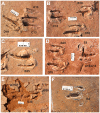Didactyl tracks of paravian theropods (Maniraptora) from the ?Middle Jurassic of Africa
- PMID: 21339816
- PMCID: PMC3038851
- DOI: 10.1371/journal.pone.0014642
Didactyl tracks of paravian theropods (Maniraptora) from the ?Middle Jurassic of Africa
Abstract
Background: A new dinosaur tracksite from ?Middle Jurassic sediments of the Irhazer Group on the plains of Agadez (Rep. Niger, northwest Africa) revealed extraordinarily well preserved didactyl tracks of a digitigrade bipedal trackmaker. The distinct morphology of the pes imprints indicates a theropod trackmaker from a paravian maniraptoran closely related to birds.
Methodology/principal findings: The early age and the morphological traits of the tracks allow for description of the new ichnotaxon Paravipus didactyloides. A total of 120 tracks are assigned to 5 individual trackways. The 'medium-sized' tracks with an average footprint length of 27.5 cm and footprint width of 23.1 cm are deeply imprinted into the track bearing sandstone.
Conclusions/significance: A comparison with other didactyl tracks gives new insights into the foot morphology of advanced maniraptoran theropods and contributes to knowledge of their evolutionary history. The new ichnotaxon takes an important position in the ichnological fossil record of Gondwana and the mid-Jurassic biota worldwide, because it is among the earliest known records of paravian maniraptorans and of didactyl theropod tracks from Africa.
Conflict of interest statement
Figures





References
-
- Scotese CR. Atlas of Earth History, Volume 1, Paleogeography, PALEOMAP Project, Arlington, Texas. 2001:52.
-
- Volkheimer W, Rauhut OWM, Quattrocchio ME, Martinez MA. Jurassic paleoclimates in Argentina, a review. Revista de la Asociación Geológica Argentina. 2008;63:549–556.
-
- Catuneanu O, Wopfner H, Eriksson P, Cairncross B, Rubidge B, et al. The Karoo basins of south-central Africa. Journal of African Earth Sciences. 2005;43:211–253. doi: 10.1016/j.jafrearsci.2005.07.007. - DOI
-
- Hallam A, Crame JA, Mancenido MO, Francis J, Parrish JT. Jurassic climates as inferred from the sedimentary and fossil record [and discussion). Philosophical Transactions of the Royal Society of London. Series B: Biological Sciences. 1993;341:287–296.
-
- Rees PM, Ziegler AM, Valdes PJ. Cambridge: Cambridge University Press; 2000. Jurassic phytogeography and climates: new data and model comparisons. In: Huber BT, Macleod KG, Wing SL, editors. Warm climates in earth history. pp. 297–318.
Publication types
MeSH terms
LinkOut - more resources
Full Text Sources

